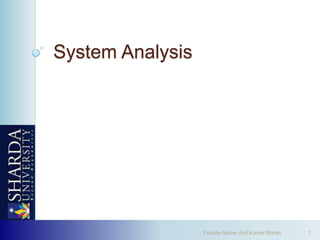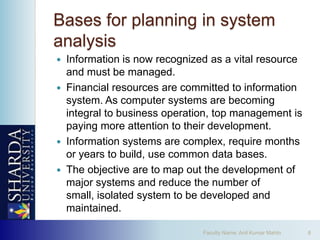System analysis
- 1. System Analysis Faculty Name: Anil Kumar Mahto 1
- 2. PLANNING AND INITIAL INVESTIGATION INFORMATION GATHERING TOOLS OF STRUCTURED ANALYSIS FEASIBILITY STUDY COST BENEFIT ANALYSIS Faculty Name: Anil Kumar Mahto 2
- 3. What is Systems Analysis? •The collection of notations, methodologies and tools used to gather details and analyze a problem situation prior to information system design and implementation •Systems analysis (or, requirements analysis) must ensure that the proposed information system meets user needs, can be delivered on time, and can be updated inexpensively.
- 4. What is a systems analyst? Responsible for designing and developing information system Liaison between users and IT professionals
- 5. SYSTEM PLANNING AND INITIAL INVESTIGATION Faculty Name: Anil Kumar Mahto 5
- 6. SYSTEM PLANNING AND INITIAL INVESTIGATION The most critical phase of managing system is planning. To launch a system investigation, we need a master plan detailing the steps to be taken, the people to be questioned, and the expected outcome. The initial investigation has the objective of determining whether the user’s request has potential merit. Faculty Name: Anil Kumar Mahto 6
- 7. By the end of this chapter, we should know- 1. Why planning is important in system analysis. 2. What planning dimension govern information system development. 3. How to determine the user’s information requirements. 4. How prototyping is used in determining information requirement. 5. What factors determining the need for a feasibility study. Faculty Name: Anil Kumar Mahto 7
- 8. Bases for planning in system analysis Information is now recognized as a vital resource and must be managed. Financial resources are committed to information system. As computer systems are becoming integral to business operation, top management is paying more attention to their development. Information systems are complex, require months or years to build, use common data bases. The objective are to map out the development of major systems and reduce the number of small, isolated system to be developed and maintained. Faculty Name: Anil Kumar Mahto 8
- 9. Dimensions of planning High interest rates make it more important that business realizes a good return on investment. Inflation puts pressure on profit when it occurs. Resource shortage impede expansion. Increased productivity paves the way for expansion. The growing trend towards guaranteed employment suggest that costs are becoming fixed and the commitment to business expansion may not be easily changed. Faculty Name: Anil Kumar Mahto 9
- 10. User’s request form to be filled by user. 1. Title of work 2. Date submission of request 3. Date of completion 4. Job Objectives 5. Expected Benefits 6. I/O description 7. Signature of requester 8. Signature of approving authority Faculty Name: Anil Kumar Mahto 10
- 11. Initial investigation The 1st step in SDLC is the identification of a need. This is a user’s request to change, improve, or enhance an existing system. There is likely to be a stream of such requests, standard procedures must be established to deal with them. The Initial investigation is one way of handling this. The objective is to determine whether the request is valid and feasible before a recommendation is reached to do nothing, improve or modify the existing system or build a new one. Faculty Name: Anil Kumar Mahto 11
- 12. Initial Investigation process 1. Problem Definition and project Initiation: • Determining users’ information requirement. 2. Background Analysis 3. Fact Finding 4. Fact Analysis 5. Determination of feasibility. Faculty Name: Anil Kumar Mahto 12
- 13. Problem Definition and Project Initiation The 1st step in an initial investigation is to define the problem that led to the user request. The problem must be stated clearly, understood, and agreed upon by the user and the analyst. It must state the objective the user trying to achieve and the result the user wants to see. Faculty Name: Anil Kumar Mahto 13
- 14. Emphasis should be on the logical requirement (what must be the result) of the problem rather than the physical requirements. For example, in the user request form, a job objective is improved customer service (logical objective). How the objective should be achieved is physical requirement. Faculty Name: Anil Kumar Mahto 14
- 15. Components of Problem Definition Describe System: What is the function of the system? Output/Input descriptions -- constraints: Dimensions, weight. Environment -- weather, temperature, moisture. Skills, ability. People -- what particular types? Systems -- higher and lower level system goals, interfaces Flows -- how do pieces fit together, what activities are there and how are they related? Components -- what are the parts and what is their purpose? Faculty Name: Anil Kumar Mahto 15
- 16. Goals: What are critical factors, characteristics of an ideal system? What is the goal of your design? How do you measure performance of the system? What is wrong with the current system? In relation to your goals? Economics -- costs, value, prices, cash flow Faculty Name: Anil Kumar Mahto 16
- 17. Background Analysis Once the project initiated, the analyst begins to learn about the setting of the existing system and the physical processes for the revised system. Faculty Name: Anil Kumar Mahto 17
- 18. Fact-Finding After obtaining this background knowledge, the analyst begins to collect data on the existing system's output, input, and cost. Review of written documents On site Observations Interviews and questionnaires Faculty Name: Anil Kumar Mahto 18
- 19. Fact Analysis I/O Analysis DFDs Decision tables Structure chart Faculty Name: Dr. Ravi Rastogi 19
- 20. Determination of feasibility After summarizing the data, the analyst has a through knowledge of the system. The following information should be available- 1. Interview Record 2. Updated system documentation 3. Flowchart 4. Specification of the good and bad features of the current system. Faculty Name: Anil Kumar Mahto 20




















